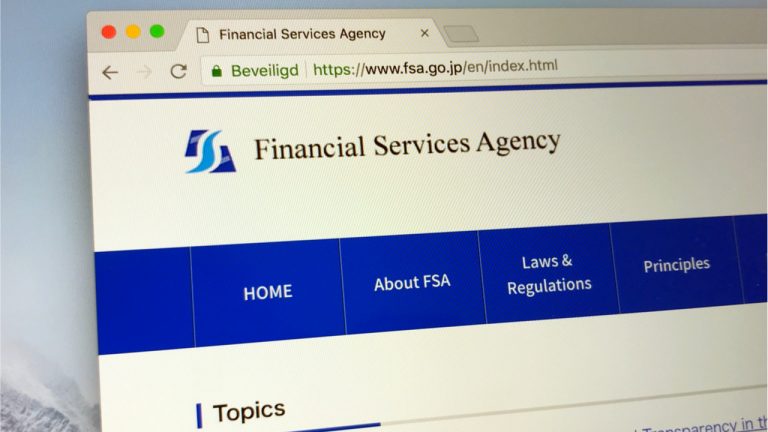
A Bloomberg exchange-traded fund (ETF) analyst says that the market could be inundated by Ethereum (ETH) futures ETFs starting on October 2nd. In a new thread on the social media platform X, Bloomberg ETF analyst James Seyffart notes that nine different ETH-based futures ETFs are set to potentially launch on Monday, adding that it will […]
The post Flood of Ethereum Futures Exchange-Traded Funds Could Launch on Monday, According to Bloomberg ETF Analyst appeared first on The Daily Hodl.

Global investment firm VanEck is preparing to roll out an Ethereum (ETH) futures exchange-traded fund (ETF) amid an optimistic outlook for the first-ever US futures ETF based on the second-largest crypto asset by market cap. In a statement published on Thursday, the firm says the VanEck Ethereum Strategy ETF (EFUT) will not directly invest in […]
The post Global Investment Manager VanEck To Launch Ethereum (ETH) Futures Exchange-Traded Fund appeared first on The Daily Hodl.

Ethereum could eventually fall afoul of the SEC, but at the moment, key data points suggest ETH is poised to hold the $1,800 level.
Ether’s (ETH) price retested $1,780 after the news of the U.S. Securities and Exchange Commission suing cryptocurrency exchanges Binance and Coinbase but it’s not preposterous to suggest that Ether bulls should be more than happy that its price did not break below the 67-day support.
The SEC actions are actually a double-edged sword for Ethereum and on crypto Twitter, some analysts attributed the bounce in Ether as a result of it not being listed as a security in either of the cases brought against Binance and Coinbase. For instance, the SEC explicitly mentioned BNB, Solana (SOL) and Cardano (ADA), which are direct competitors to Ethereum’s smart contract processing capabilities.
However, as noted by analyst Jevgenijs Kazanins, Ether’s omission does not mean that it has the green light from the SEC.
SEC did not mention #ETH in the list of tokens that it considers to be securities when suing Coinbase and Binance. Could it be that the SEC is working on a separate lawsuit targeting Ethereum Foundation?
— Jevgenijs Kazanins (@jevgenijs) June 6, 2023
Kazanins raises the question of whether the SEC could be targeting the Ethereum Foundation in a separate lawsuit. For now, the idea is a mere unfounded speculation, but it certainly has merit given that SEC chairman Gary Gensler refused to answer questions about Ethereum’s status before the U.S. House Financial Services Committee in April 2023.
In the meantime, what we can focus on is Ether’s price action, network data and other data which impacts investor sentiment and price in the short-term.
TVL measures the deposits locked in Ethereum's decentralized applications, which have been in a downtrend since mid-March. The indicator reached a 14.35 million ETH bottom on June 3, but bounced back to 14.6 million ETH by June 6, according to DefiLlama.
The number of active addresses interacting with decentralized applications (DApps) is also in a slump. Over the last 30 days, the top 12 DApps running on the Ethereum network saw a 4% increase in active addresses, even though the average transaction gas fee remained above $6.5.

If investors fear that Ether has higher odds of breaking below the $1,800 support, it should be reflected in the ETH futures contract premium and increased costs for protective put options.
Ether quarterly futures are popular among whales and arbitrage desks. However, these fixed-month contracts typically trade at a slight premium to spot markets, indicating that sellers are asking for more money to delay settlement.
As a result, ETH futures contracts in healthy markets should trade at a 4 to 8% annualized premium — a situation known as contango, which is not unique to crypto markets.

According to the futures premium, known as the basis indicator, professional traders have been avoiding leveraged longs (bullish bets). Still, not even the retest of the $1,780 level on June 6 was enough to flip those whales and market makers into bearish sentiment.
To exclude externalities that might have solely impacted the Ether futures, one should analyze the ETH options markets. The 25% delta skew indicator compares similar call (buy) and put (sell) options and will turn positive when fear is prevalent because the protective put option premium is higher than the call options.

The skew indicator will move above 8% if traders fear an Ether price crash. On the other hand, generalized excitement reflects a negative 8% skew. As displayed above, the 25% delta skew moved above the positive 8% threshold on June 5, indicating bearishness. However, the subsequent bounce to $1,880 on June 6 has moved the metric back to a neutral state.
Related: Coinbase reminds world it tried to ‘embrace regulation’ as SEC sues for violations
In short, these three indicators signal resilience — namely, the TVL bounce to 14.6 million ETH, the 4% increase in Dapps active addresses, and a meager impact on Ether derivatives markets despite the retest of the $1,800 level.
Ethereum network usage data remains healthy and the recent retest of the 67-day support was not enough to scare professional traders, according to derivatives metrics.
Consequently, bulls seem to have dodged a bullet, greatly reducing the risk of an imminent price crash.
This article is for general information purposes and is not intended to be and should not be taken as legal or investment advice. The views, thoughts, and opinions expressed here are the author’s alone and do not necessarily reflect or represent the views and opinions of Cointelegraph.
This article does not contain investment advice or recommendations. Every investment and trading move involves risk, and readers should conduct their own research when making a decision.

Ethereum traders are betting on a "sell-the-news" event on the day of the Merge as ETH exchange balance jumps.
Ethereum successfully completed its long-awaited transition to proof-of-stake via "the Merge" on Sep. 15, while traders have been increasingly shorting Ether (ETH) in anticipation of a sell-the-news event.
Ether's futures funding rates across leading derivatives platforms dropped below zero—to their worst levels to date—before the Merge. The rate dropped to as low as -0.6% on BitMex.

Funding rates are a percentage of the fee paid to either short or long position holders. The platform decides the fee based on the difference between the perpetual futures contract and the spot price.
Therefore, traders consider a market bullish when the funding rate is positive. Conversely, a negative funding rate hints at a bearish sentiment in the market. Let's understand why with an example.
Currently, Ether's funding rate average is around -0.1%. In other words, traders with a $1 million short ETH position are willing to pay those with long positions $1,000 every eight hours (based on when platforms recalculate the funding rates).
That shows traders' conviction in a potential spot Ether price drop after the Merge.
However, a consistently negative funding rate also increases the possibility of a short squeeze. A short squeeze occurs when an asset moves higher and short traders decide to cover their position or get forced to do so via margin calls, thus adding more upside strength to the asset's price.
From a technical perspective, Ether's price risks dropping by 50% in the coming weeks due to the formation of a symmetrical triangle on its longer-timeframe chart.
Notably, symmetrical triangles are trend continuation patterns, i.e., they typically prompt the price to continue in the direction of their previous trend after a consolidation period. So, Ether's symmetrical triangle pattern appears bearish, particularly as it has formed after the token's 80% decline from its November 2021 highs.

Theoretically, a bearish symmetrical triangle's downside target is calculated after subtracting the triangle's maximum height from the breakdown point. That puts ETH's profit target in 2022 around $850.
In addition to negative funding rates and the symmetrical triangle setup, Ether also faces downside risks from a renewed buying interest in Bitcoin (BTC), the leading cryptocurrency by market capitalization.
On the daily chart, ETH/BTC dropped to 0.078 BTC on Sep. 15, almost a week after topping out at 0.085 BTC. The pair's correction came after a strong bull cycle, wherein its price rose by more than 75% in less than three months.

"ETH's underperformance ahead of the merge indicates that some traders attempt to front run a potential "sell-the-news" event," noted Arcane Research in its weekly report, albeit adding:
"Whether or not the merge will turn out to be a 'sell-the-news' event remains to be seen."
In another weekly report, investment management firm CoinShares reported a substantial decline in the capital of Bitcoin and Ethereum-based investment products.
Related: Analyst on $17.6K BTC price bottom: Bitcoin 'not there yet'
However, Ether funds witnessed withdrawals worth $61.6 million in the week ending Sep. 9 compared to Bitcoin's $13 million.
More sell-the-news cues come from a recent rise in Ethereum's balance across all crypto exchanges. Notably, the Exchange inflow volume reached a one-month high of 22,723.289 ETH (7-day MA).

Traders typically increase their cryptocurrency deposits on exchanges when they want to sell their holdings. In other words, a rising ETH balance on exchanges increases downside risks.
The views and opinions expressed here are solely those of the author and do not necessarily reflect the views of Cointelegraph.com. Every investment and trading move involves risk, you should conduct your own research when making a decision.
 On Tuesday, the world’s largest financial derivatives exchange, Chicago Mercantile Exchange (CME) Group, announced the upcoming launch of ethereum-based micro futures slated to be listed on December 6. The launch follows CME Group’s bitcoin micro futures listing in May, which saw 100,000 micro bitcoin futures traded during the first six days after launch. CME to […]
On Tuesday, the world’s largest financial derivatives exchange, Chicago Mercantile Exchange (CME) Group, announced the upcoming launch of ethereum-based micro futures slated to be listed on December 6. The launch follows CME Group’s bitcoin micro futures listing in May, which saw 100,000 micro bitcoin futures traded during the first six days after launch. CME to […] The Japanese government’s Financial Services Agency (FSA) has issued a warning to the crypto derivatives exchange Bybit claiming that the trading platform is allowing residents of Japan access to the exchange. The news follows the Bank of Japan Governor Haruhiko Kuroda criticizing digital currencies for speculation. Japan’s FSA Warns Bybit Fintech Limited Japan’s top regulator […]
The Japanese government’s Financial Services Agency (FSA) has issued a warning to the crypto derivatives exchange Bybit claiming that the trading platform is allowing residents of Japan access to the exchange. The news follows the Bank of Japan Governor Haruhiko Kuroda criticizing digital currencies for speculation. Japan’s FSA Warns Bybit Fintech Limited Japan’s top regulator […]
Open interest in Ether options trading has increased from $50 million to $4 billion over the last year.
The massive growth of Ethereum’s futures and options arena is reportedly pointing toward significant institutional involvement in the second-largest cryptocurrency by market capitalization.
According to a recent report by crypto investment advisory firm Two Prime Digital Assets, the 80-fold growth in Ether (ETH) options open interest goes beyond mere retail speculation. As part of its report, the firm argued: “Institutional money managers have moved in to start hedging net long portfolios against outsized volatility events.”
The same exponential growth can also be seen in the ETH futures market. Indeed, data from crypto aggregator Bybt shows the open interest in ETH futures experiencing a 20-times increase within the same period and now sits at over $7.68 billion as of the time of writing.

Amid the growing institutional demand for ETH, Two Prime also predicted that Ether will decouple significantly from Bitcoin’s (BTC) price action. The Two Prime report also maintained that the involvement of big-money players will cause a steady decrease in realized volatility.
In another example of the apparent increase in institutional appetite for Ethereum, the CoinShares “Digital Asset Fund Flows Weekly” report saw ETH bucking the trend of investment product outflows for crypto assets.
According to the crypto investment manager’s report on Monday, ETH saw $34 million in investment product inflows for the past week. This figure puts the total ETH inflow for crypto fund managers at $792 million — about 8% of the total asset under management for these funds, according to CoinShares.
The $34-million ETH investment inflow came amid Bitcoin’s lowest weekly inflow numbers since October 2020. Indeed, fund movements were primarily outflows for BTC, with $21 million (the largest weekly outflow recorded) moving the other way.
As previously reported by Cointelegraph in February, ETH represented about 80% of the institutional crypto inflows in the first week of the month.

Futures traders are increasingly bullish on Ether price in the short-term with $2,500 now in play.
Now that Ether's (ETH) price broke the $2,000 level, hitting all-time highs this week, traders became excessively bullish and are expecting more upside in the short-term.
Some analysts believe Visa's initial USD Coin (USDC) stablecoin transaction settlement on the Ethereum network kicked off the most recent rally. Others attribute the current Ether hike to a "triangle market structure" breakout.
Regardless of the cause behind the recent 25% rally, professional traders seem highly optimistic this time around. This conclusion can be reached by looking at the surging futures’ basis, which has reached its highest level ever.
This movement brings increased risks of cascading liquidations due to excessive buyer leverage, but professional traders seem confident, as shown by the delta skew indicator.

Investors could be anticipating the protocol improvement proposal EIP-1559 set to go live in July, which aims to fix the surging gas fees. The upgrade intends to use flexible block sizes instead of the current fixed model, and it aims for a network utilization below 50%.
To assess whether professional traders are leaning bullish, one should start by analyzing the futures premium (also known as the basis). This indicator measures the price gap between futures contract prices and the regular spot market.

The 3-month futures should usually trade with a 10% to 20% annualized premium, comparable to the stablecoin lending rate. By postponing settlement, sellers demand a higher price, causing the price difference.
The basis on Ether futures has matched its all-time high at 38%, indicating that it is costly for the leveraged longs. A basis level above 20% is not necessarily a pre-crash alert, but buyers' overconfidence might pose a risk if the market recedes below $1,750.
It is worth noting that traders sometimes boost their leverage use during a rally but later purchase the underlying asset (Ether) to unwind the risk from futures.
Sometimes the fixed-month contracts’ high leverage is a consequence of perpetual futures aggressive buying by retail traders. Whales, arbitrage desks, and market makers avoid exposure on these contracts due to their variable funding rate.
To correctly interpret how professional traders are balancing the risks of unexpected market moves, one should turn to the options market.
The 25% delta skew provides a reliable and instant "fear and greed" analysis. This indicator compares similar call (buy) and put (sell) options side by side and will turn negative when the neutral-to-bearish put options premium is higher than similar-risk call options. This situation is usually considered a "fear" scenario, although frequent after solid rallies.
On the other hand, a negative skew translates to a higher cost of upside protection and points toward bullishness.

For the first time since Feb. 5, the options skew indicator is leaning bullish, although it is not far from the negative 10% neutral threshold. Furthermore, the "fear and greed" indicator has continuously improved over the past five weeks.
Part of the reason behind the modest optimism lies in fear of a sharp correction after crossing the $2,000 psychological barrier, similar to the one seen on Feb. 19.
This time around, however, the derivatives markets are healthy, and professional traders appear to be building up positions as Ether marks a new all-time high.
The views and opinions expressed here are solely those of the author and do not necessarily reflect the views of Cointelegraph. Every investment and trading move involves risk. You should conduct your own research when making a decision.